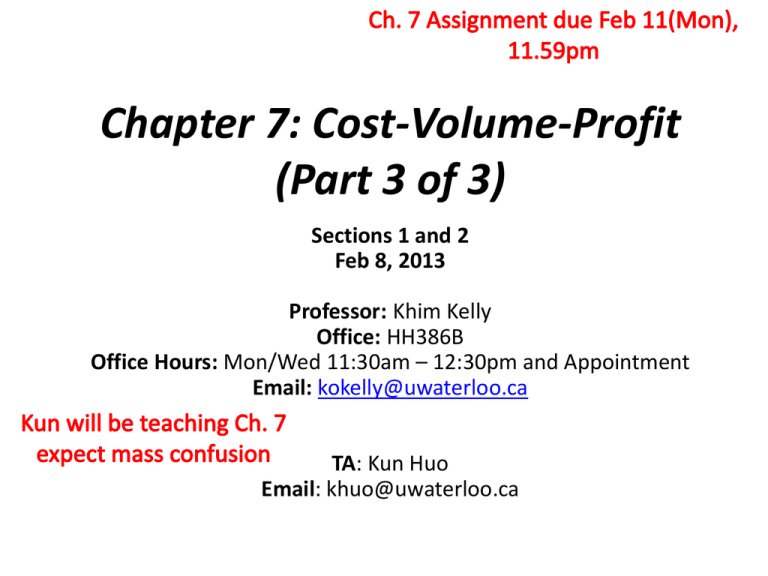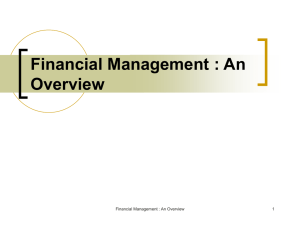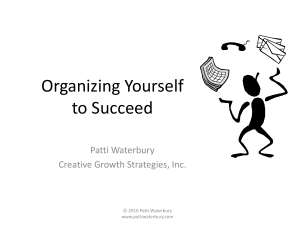AFM102_2013_Feb8_BeforeClass
advertisement

Chapter 7: Cost-Volume-Profit (Part 3 of 3) Sections 1 and 2 Feb 8, 2013 Professor: Khim Kelly Office: HH386B Office Hours: Mon/Wed 11:30am – 12:30pm and Appointment Email: kokelly@uwaterloo.ca TA: Kun Huo Email: khuo@uwaterloo.ca 8 Feb 2013 Overview • Last lecture … – More break-even analysis – Margin of Safety analysis – Target operating profit analysis • Today’s lecture … – Cost Structure Choice and Leverage – Indifference analysis – Multi-product Settings 2 Cost structure choice • Company can choose a particular cost structure (i.e., relative proportion of fixed and variable costs) Which cost structure is better (more fixed costs or more variable costs)? • – • Depends on many factors Concept of leverage plays a key role in the analysis 3 “Give me a place to stand and with a lever I will move the whole world” Operating Leverage CM OI Measure of the sensitivity of OI to % change in sales Degree of Operating Leverage = • – – – • Acts as a multiplier Higher leverage: small change in sales leads to larger shift in OI Differs at any level of sales (i.e. valid at given X only), greatest at break-even point and decreases as sales increases Cost structure drives leverage – – More FC rather than VC yields greater leverage Drive to automation? 5 Leverage Graph: Cost Structure Total Sales Revenue $ High FC Case A: Total Expenses Break-even Point Case B: Total Expenses Lower FC results in a lower breakeven point (Fixed expenses/unit CM), so less risk of losses when sales decrease Low FC Activity Leverage Graph: Cost Structure $ Which has a greater degree of operating leverage at point X: A or B? Total Sales Revenue X Case A: Total Expenses Case B: Total Expenses Higher FC (higher CM) results in higher leverage (CM/OI), so better upside potential in profits when sales increases High FC Low FC Activity Operating Leverage Example 1 Degree of Operating Leverage = Rev VC CM FC OI Units Degree of Leverage Per Unit $100 $60 $40 Income $100,000 $60,000 $40,000 $30,000 $10,000 Income $110,000 $66,000 $44,000 $30,000 $14,000 1,000 1,100 CM OI Sales increase by 10% OI increases by 4 times (i.e., 40%) 4 8 Operating Leverage Example 2 Degree of Operating Leverage = Rev VC CM FC OI Units Degree of Leverage Per Unit $100 $30 $70 Income $100,000 $30,000 $70,000 $60,000 $10,000 Income $110,000 $33,000 $77,000 $60,000 $17,000 1,000 1,100 7 CM OI Same total sales Same total expenses, but greater proportion of FC Sales increase by 10% OI increases by 7 times (i.e., 70%) Higher FC (higher CM) results in higher leverage (CM/OI), so better upside potential in profits when sales increases 9 The critical assumption about leverage • As fixed cost increases, variable cost will come down – More roads and infrastructure, people are more productive because they spend less time on the travel – Bigger class rooms, fewer instructors need to be hired It is Clicker Time!! Feel Free to Work Together on Clicker Questions Clicker Question #1 Green Company's variable expenses are 75% of sales. At a sales level of $400,000, the company's degree of operating leverage is 8. At this sales level, fixed expenses equal which of the following? A) B) C) C) D) $87,500. $100,000. Dogbert $12,500. $75,000. 12 Clicker Question #1: Answer Green Company's variable expenses are 75% of sales. At a sales level of $400,000, the company's degree of operating leverage is 8. At this sales level, fixed expenses equal which of the following? Answer: 13 Clicker Question #2 If two companies produce the same product and have the same total sales and same total expenses, operating leverage will be lower in the company with a higher proportion of fixed expenses in its cost structure. A. True B. False Leverage Graph: Cost Structure $ Which has a greater degree of operating leverage at point X: A or B? Total Sales Revenue X A - Total Expenses B - Total Expenses High FC Indifference Point (indifferent wrt profit between high FC vs. low FC) Low FC Activity Indifference Point (P7-31) 1) Find equations for both cost lines 2) Set the two equations equal to each other and solve for X Item DM per unit DL per unit Variable OH per unit Cost 1 $9.00 1.2 DLH @ $14/DLH 0.75 of DL costs Cost 2 $7.50 0.75 DLH @ $18/DLH 0.60 of DL costs Fixed Man. Costs Fixed S&A Selling Price per unit $1,108,000 $1,685,000 $60.00 $1,494,000 $1,685,000 $60.00 Variable Selling Cost per unit $4.00 $4.00 16 Cost 1 Equation … Item Cost 1 DM per unit DL per unit Variable OH per unit $9.00 1.2 DLH @ $14/DLH 0.75 of DL costs Fixed Man. Costs $1,108,000 Fixed S&A $1,685,000 Selling Price per unit $60.00 Variable Selling Cost per $4.00 unit VC per Unit: = $9 + ($14*1.2) + ($14*1.2*0.75) + $4 = $42.40 per unit Fixed Costs: = ($1,108,000 +$1,685,000) = $2,793,000 Cost 1 Equation Y = $2,793,000 + $42.40X 17 Cost 2 Equation … Item DM per unit DL per unit Variable OH per unit Cost 2 $7.50 0.75 DLH @ $18/DLH 0.60 of DL costs Fixed Man. Costs Fixed S&A Selling Price per unit $1,494,000 $1,685,000 $60.00 Variable Selling Cost per unit $4.00 VC per Unit: = $7.50 + ($18*0.75) + ($18*0.75*0.60) + $4 = $33.10 per unit (Lower VC per unit) Fixed Costs: = ($1,494,000 +$1,685,000) = $3,179,000 (Higher Total FC) Cost 2 Equation Y = $3,179,000 + $33.10X 18 Cost 1 = Cost 2 Set Cost 1 equation equal to Cost 2 equation to determine the point of indifference: Cost 1 = Cost 2 $2,793,000 + $42.40X = $3,179,000 + $33.10X $9.30X = $386,000 X = 41,505 (rounded) units The point of indifference in cost structure occurs when 41,505 units are produced and sold. It is Clicker Time!! Feel Free to Work Together on Clicker Questions Clicker Question #3 Company Y is considering two production technologies for producing its new product. The cost structures of the two technologies are as follows: Selling Price / Unit Variable Production Costs / Unit Total Fixed Production Costs Bronze Platinum $ 150 $ 150 $ 120 $ 50 $300,000 $1,210,000 Q: At what sales volume in units (rounded to the nearest whole unit) would Company Y be indifferent in technologies? 21 Clicker Question #3 Q: At what sales volume in units (rounded to the nearest whole unit) would Company Y be indifferent in technologies? A) B) C) D) E) 10,000 units. 12,100 units. 13,000 units. Infinite number of units Cannot be determined without additional information. 22 Sales Mix • Overall sales volume is very important to an organization • The mix of sales also matters – Low CM products? High CM products? • Relative proportions of product sales – Expressed as a % of Total Sales • Sum across products – Revenue – Variable Cost • Fixed cost comes last 23 Budgeted Sales Mix (P7-20) % of Total Sales VC CM FC OI CMR Sinks 48% $240,000 Mirrors 20% $100,000 Vanities 32% $160,000 Total 100% $500,000 72,000 $168,000 80,000 $20,000 88,000 $72,000 240,000 $260,000 223,600 70% 20% 45% $36,400 52% Q: What is Break-Even Sales Point given actual sales mix? It is Clicker Time!! Feel Free to Work Together on Clicker Questions Clicker Question #4 Sinks Mirrors Vanities Total % of Total Sales VC CM FC OI CMR 223,600 70% 20% 45% Q: Actual sales mix: Sinks: $160,000; Mirrors: $200,000; Vanities: $140,000. What is breakeven sales? Clicker Question #4 Q: Actual sales mix: Sinks: $160,000; Mirrors: $200,000; Vanities: $140,000. What is breakeven sales? A. B. C. D. E. That is a good question $520,000 $550,000 $580,000 $610,000 Important points • Leverage: – Beyond the break even point, higher leverage means that you receive higher profit per unit sold. – Higher leverage likely means higher fixed costs, so the break even point is harder (more units) to reach • Indifference means given two cost structures, the profits are equal at some activity level • In the real world, you would use a computer for multi-product analysis because sales mixes will not remain equal Summary • Today’s lecture … – Cost Structure Choice and Leverage – Indifference analysis – Multi-product Settings • Next lecture … – Prof Kelly returns to lecture (Hooray!!) – Introduction to Variable Costing (Chapter 8)





